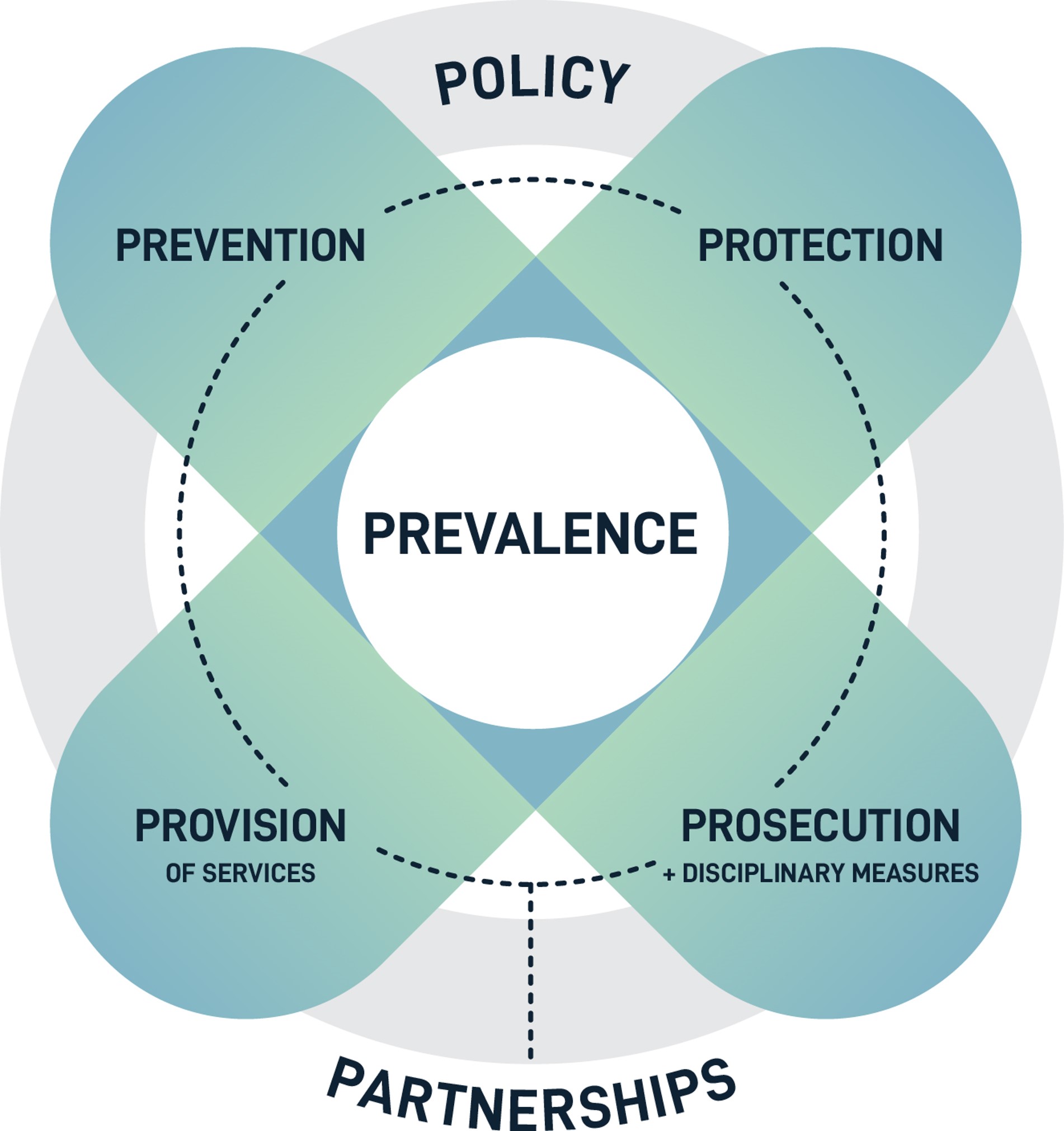refers to measures that promote changes in social and cultural behaviour and attitudes of all members of the institutional community. In academic context, this may include induction materials for both staff and students; internal and external publicity and training; public statements and awareness-raising campaigns.
The 7P Framework
Theorising gender-based violence policies
UniSAFE uses a holistic framework for the analysis, assessment and development of comprehensive policies aimed at ending and addressing gender-based violence, called the 7P model. The seven Ps refer to Policy, Prevalence, Prevention, Protection, Prosecution and internal disciplinary measures, Provision of services and Partnerships. This model thus extends the conventional UN’s and EU’s 3P approach (prevention, protection, prosecution) (UN 2017; EU 2019, 2020), as well as the Council of Europe’s (2011) Istanbul Convention’s 4P approach (prevention, protection, prosecution, policies).
It is important to emphasise that within the 7P framework, measures can have an impact on multiple Ps, and the boundaries between these Ps are not always clearly defined.
Information about the history of the model and advanced definitions for each P can be found in the article by Mergaert, L., Linková, M. & Strid, S. (2023). Theorising Gender-Based Violence Policies: A 7P Framework. Social Sciences, 12(7), 385 (accessible here).
The definitions of the 7 Ps
Policy
Policy is the basis of the 7P approach and refers to:
a) policy frameworks, which refer to coherent sets of measures with a clear vision and comprehensive strategy that respond to incidents of gender-based violence in an integral and structured way; and
b) policy documents which formalise explicitly and specifically the organisation’s commitment to addressing gender-based violence.
Protection
aims to ensure safety and meet the needs of (potential) victims/survivors. This includes clear processes, procedures, and infrastructure for reporting occurrences and supporting people who report gender-based violence. Protective measures should address victims/survivors, bystanders, whistle-blowers, intermediaries and anybody who may be exposed to risk of gender-based violence or retaliation. Protection also includes training for those responsible for handling cases. Protection may comprise precautionary measures such as a restraining order or offering a change of dormitory, student group, unit, or supervisor.
Prosecution
refers specifically to disciplinary measures against (alleged) perpetrators, related investigative measures, and sanctions. This includes possible warnings, suspension, termination of employment and study, as legally appropriate, and it may also involve judicial proceedings and liaison with external actors, including police and lawyers.
Provision of Services
refers to the services offered to support victims/survivors, families, bystanders, (alleged) perpetrators of gender-based violence and community members affected by it. Provision of services also refers to the professionals who provide the services (e.g. those involved in specialised training) and the existing tools to assist in better addressing the needs of the target groups.
Partnerships
relates to the involvement of relevant actors at all levels, such as governmental agencies, civil society organisations, service providers, trade unions, or staff and student associations. External partnerships complement the available skills, competencies and expertise available within the institution.
What is intersectionality and how is it mainstreamed in this toolkit?
Intersectionality is a valuable framework that makes it possible to analyse and understand the interconnected nature of various forms of inequality, such as gender, race, class, sexual orientation, and personal characteristics. By considering how these different factors intersect and interact, a better understanding can be gained of how individuals may experience distinct forms of disadvantage and discrimination.
When studying gender-based violence, incorporating an intersectional perspective is essential. It provides insights into how individuals with diverse characteristics and backgrounds encounter unique types of violence and oppression. This understanding is crucial to address gender-based violence effectively.
In the specific context of this toolkit, the concept of intersectionality plays an important role in providing guidance and recommendations for the practical implementation of the 7P Framework. Throughout the various components of the toolkit, intersectionality is addressed with practical tips and advice on how to incorporate intersectional approaches, ensuring inclusiveness and sensitivity in addressing gender-based violence.



 The contents of this website were developed by Yellow Window and do not necessarily reflect the views of the EC. This project has received funding from the European Union’s Horizon 2020 research and innovation programme under grant agreement no. 101006261
The contents of this website were developed by Yellow Window and do not necessarily reflect the views of the EC. This project has received funding from the European Union’s Horizon 2020 research and innovation programme under grant agreement no. 101006261